You are reading the older HTML site
Positive Feedback ISSUE
16
november/december 2004
harmonix
Harmonic Strings cables
as reviewed by Marshall Nack
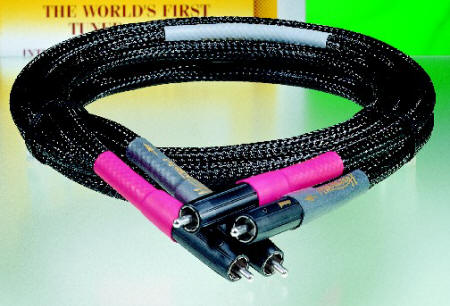
|
MARSHALL NACK'S SYSTEM
LOUDSPEAKERS
ELECTRONICS
SOURCE
CABLES
ACCESSORIES
|
The two things I like most about Harmonix cables, or Harmonic Strings (HS), as the manufacturer calls them, are their uncommon fullness and purity, both of which make for a very robust and convincing presentation. By far, the majority of new cable arrivals fall into the bright and/or lean sounding camp. Very few, if any, have both adequate fullness and the right tonal balance. The HS belong in that other category—they have such an amazing amount of weight, it was necessary to make a tonal shift in the opposite direction. This is easy enough to do with any number of tweaks available to the audiophile. And the result was a beautiful tonal balance and addictive musical weight.
One thing I don't like about the HS—you'll need to wait while they accumulate about five hundred hours of break-in. Sad but true, and important, but we'll get to that later.
Shaken, not Stirred Tactile and Timbral Sensation
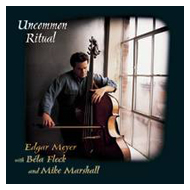 Throw on a CD like
Uncommon Ritual (Sony SK62891). Do the names Bela Fleck, Mike
Marshall or Edgar Meyer mean anything to you? Each is a luminary on his
respective musical turf. The three perform mostly Edgar Meyer bluegrass
compositions, salted with some jazz overtones, taking turns exchanging
riffs, playing off each other. Edgar, my hero, is the featured artist,
so you know there are interesting rhythms and melodies here. His wit is
in evidence all over the place—this is fun stuff. Edgar's facility on
the double bass is astounding. On some CDs he tackles the cello
repertory; on this one he pulls off a Pablo de Sarasate violin showpiece
he arranged for bass with mandolin accompaniment.
Throw on a CD like
Uncommon Ritual (Sony SK62891). Do the names Bela Fleck, Mike
Marshall or Edgar Meyer mean anything to you? Each is a luminary on his
respective musical turf. The three perform mostly Edgar Meyer bluegrass
compositions, salted with some jazz overtones, taking turns exchanging
riffs, playing off each other. Edgar, my hero, is the featured artist,
so you know there are interesting rhythms and melodies here. His wit is
in evidence all over the place—this is fun stuff. Edgar's facility on
the double bass is astounding. On some CDs he tackles the cello
repertory; on this one he pulls off a Pablo de Sarasate violin showpiece
he arranged for bass with mandolin accompaniment.
The liner notes detail the instrumentation on each track. It changes often, but I never paid it much mind. Or, I should say, I read the liner notes so I knew about instrument changes, but I couldn't hear them. The system didn't tell me enough about what was going on. A good example of this is the intro to Track 4. Each musician plucks a single note, passing the melody to the next player in a cute round robin. I got the melody, but I sure couldn't tell who was playing what.
Post "Harmonization," with the entire signal path using top-of-the-line HS cable, I no longer needed the liner notes. Now, a single plucked note is enough to tell me with certainty there's a banjo on the left, a double bass down center and a mandolin on the right. When Edgar Meyer plays, it's impossible not to recognize the percussive thump behind the pizzicato as the wooden body of the instrument is excited. Likewise, it's easy to discern Bela Fleck switching from a regular banjo to "low" banjo or Mike Marshall from National Resonator guitar to mandolin. Changes like this, even among very similar instruments, have become quite obvious. All this musical definition was aided by a great deal more weight and body in the mid-bass through the mid-range. Plucked strings have a markedly more tangible and palpable feel. However, it's a controlled weight that avoids flabbiness—there is actually less boominess and better focus down below.
Brightness, that ubiquitous bugaboo, is practically banished. The treble becomes less prominent, less aggressive, resistant to break-up and, indeed, more pure. It is adequately extended and has more body, although still less than the midrange and bass. Grain and other artifacts recede into the background. Warm, with lots of texture, yet reasonably close to neutral, the presentation is big and robust—it can get larger than life if you're not careful. While speed, dynamics and detail are approximately the same as before, you get the impression there's more speed, that it's more dynamic. And it is somehow never hard or abrasive on the ear—everything has actually become smoother.
I could be talking about any product in the Harmonix catalog here because there's so much in common. This is the Harmonix signature.
Tuning Theory
I described the theory in my Harmonix Tuning Products Part I review:
"According to their brochures, Harmonix engineers began their R & D by studying the resonance characteristics of fine violins in order to ‘understand how beautiful sound is produced in the first place.' They ‘found that resonance in a violin is perfectly balanced in one frequency.' When you excite one of its strings, the body of the violin doesn't just make the sound louder, it tunes the sound to carefully selected frequencies, and then amplifies it. The engineers applied this to audio products to ‘eliminate unwanted resonance frequencies to achieve…pure, distortion-free reproduction,' through tuning. So, if you tune resonances and remove noise, especially treble noise, imitating the way a violin controls resonance, the sound you are left with is clean and pure, completely integral with the note; instruments sound like they are played more accurately; musical lines become easy to follow."
How this happens is not revealed, but, I tell you, the warmth, weight and purity often make me feel like I'm in a cozy, wood-paneled concert venue. And maybe I am—when listening to The Spirit of Gambo, music of Tobias Hume, performed by the period instrument viol consort Labyrinto (Glossa GCD 920402). Labyrinto's instruments range from the viole de game soprano through the basse de viole and the violone. The reproduced string tone is simply marvelous through the HS—full range, highly resonant, loaded with texture and unloaded of grain and artifacts. There sure are a whole lotta overtones going on here. Bass frequencies, of course, are well served. Treble extension is good and linearity is excellent—the HS avoids the whininess I've often heard on this CD and dismissed as due to the period instrument strings. There's a treat waiting for you, namely Emma Kirkby, who joins the ensemble on a handful of tracks. For those of you who don't know, Emma has a very pure high soprano. She'll test your systems' treble, and trust me, you don't want to lose control of Emma's top notes. With the HS, you have much less to fear on that score: the wire almost never loses its grip on the top end. If you have treble issues, you'll be smiling at the HS's performance—it's almost hard to make them sound strident.
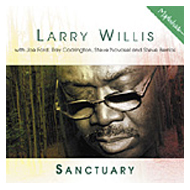 Sanctuary
(Mapleshade MS 09932), features pianist Larry Willis, Mapleshade's music
director, in small jazz combo settings. Most of the tunes are low-key,
intimate arrangements taken at largo tempi, exploring matters of
the soul and spirit.
Sanctuary
(Mapleshade MS 09932), features pianist Larry Willis, Mapleshade's music
director, in small jazz combo settings. Most of the tunes are low-key,
intimate arrangements taken at largo tempi, exploring matters of
the soul and spirit.
From the very beginning of track 2 your attention is drawn to the weightiness and richness of the piano. The Fazioli piano employed for the session sounds different from a Steinway, to my ear more like the slightly darker Bosendorfer. The same applies to the classical string section that comes in a minute later on the right. It's interesting how the success of including unexpected instruments (the strings) is impacted by how well they are reproduced—as mentioned, string tone is wonderfully served by the HS. This is a feel-good beginning, a little warmer and a little richer than the real thing, perhaps also a little darker and weightier, but it sure sounds good. The soundstage fills the room—very wide, imaging outside the speakers, with equally good depth and image height. And then your happiness is disturbed by odd noises emanating from the left channel, which seem to mimic the piano. These turn out to be sympathetic resonances from the snare drum. I can hear this noise all too clearly—why wasn't the trap-set locked? Well, at least I'm not left guessing about the origin of that buzzing noise. While we're at it, the left of center cymbal is too prominent, both in image size and treble energy: it has too much sizzle and the balance is off. Details of this kind are easy to pick out, and I mention them to demonstrate the HS's Class A resolving power.
Where's the "air"?
The quality of "air" in the HS soundstage is different from what we're used to hearing in high-end systems. Tuning and noise removal drain the sounds around the instrument. When applied in large doses, not only the noise but also the acoustic halo around the note—what we're used to calling "air"—is affected. The result is that the note itself is clearer and more solid than ever, but you don't have the familiar upper mid/low treble aura around instruments. I noted this with some alarm, but, you know what, over time I got used to it—now I wonder if it isn't more true to life. Do we actually hear this? Now that I'm paying attention, I can't say I do. I can put back as much of this "air" as I'd like by taking out one of the HS wires or one of the battery of Harmonix Tuning products I have in place. Suffice it to say this only becomes noticeable when a lot of Harmonix stuff is used.
The other byproduct of noise removal and enhanced weight is very solid, dense images. They are big, with soft edges, and populate a well-defined, dimensional and stable soundstage. The stability of the instruments on the stage is extreme—that, plus their weightiness, gives them an almost physical presence. This is something I've heard with a few other, carefully selected wires, but never to this extent. It makes for a very convincing presentation.
Delving a little deeper into the HS soundstage, there is a small price to be paid. The very attractive stability and solidity responsible for the convincing impression also imbues images with a kind of coarse or brusque quality, as if they're standing rigidly at attention. And, while the tonal center of gravity of the HS is in the mid-range, there's a tendency for sounds to finish favoring the lower frequencies. All of these things hamper the images' ability to "dance" on the stage. I would like them to be a little looser, more fluid and free.
Some cables, like the Stealth Audio GS-50-50 interconnect or the Harmonic Tech Magic, are able to sound weighty, keeping the low frequencies open, while finishing with more treble. This gives their images more lift and dance-like qualities. But, then again, their stage is not as solid and the presentation is not as convincing. The HS also has a tendency to group instruments together, so an entire section of violins can sound like one big instrument—it's those soft edges. Image size is bigger and focus is a little softer than with some other cables.
But don't get the idea that the HS can't boogie. Au contraire, mon ami. The images may not be light on their feet and the presentation may not be as subtle as with some other cables, but boy-oh-boy, the PRAT (Pace, Rhythm and Timing) quotient was off the curve. In terms of communicating and involving the listener, the HS get top marks. Typically, guys' reaction was one of the Funky Chicken variations. (More than once I had to look away—better not to watch these middle-aged couch potatoes trying to groove.) Oft heard comments were, "Ain't no brightness nowhere," and "This sounds closer to real." There is a lesson to be learned here about system voicing priorities. Let's not forget that music is about a lot more than subtleties—concentrate first on getting the message across. Later on you can tweak for subtleties. To my mind, the number-one priority has to be realistic tone and body. Get this, and then tackle detail resolution, sound staging, etc. Don't go about it the other way around. You're much better off if people can relate to and enjoy your presentation, even if it ain't high-def. The reverse, a presentation that's all about incredible definition, but has fake tone and timbre, is what turns off the general public to high-end audio.
Appearance and Construction
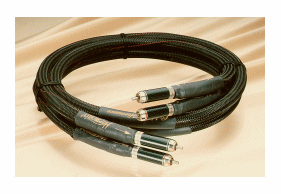
The Harmonic Strings HS-101GP (Golden Performance) top-of-the-line interconnect cable is a bit larger in diameter than most interconnects and noticeably heavier and less flexible. Your choice of color is designer black or designer black. The HS-101GP are fitted with proprietary carbon-finished locking RCAs, with fancy covers sporting a green and black snakeskin design, and mate snugly with female jacks. The interconnect has an external ground wire terminated in a small spade, much like a phono cable. I tried grounding it, but can't say I noticed a difference.
The Harmonic Strings HS-102 digital cable is wholly different in appearance than the analog interconnect. The cable is thin, light and bends easily, especially at the point right after the RCA plugs, where it could use some reinforcement. It has much simpler push-on type RCAs, which appear to be of Harmonix design. Most interconnects and digital cables have the hot and return wires encased in a single sheath with a common dielectric, so they look like one wire. The HS-102 is unusual in that you can see and feel the two conductors under the canary yellow sheath—they don't have a common shield/dielectric. The HS-102 doesn't have an external ground wire like the HS-101GP interconnect.
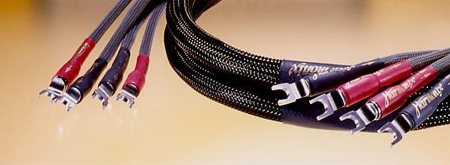
The Harmonic Strings HS-101 SLC (Sophisticated Listeners Choice) speaker cable is sheathed in dark greenish black. There's one cable per side containing both signal and return conductors. It's a lot larger and heavier than the Harmonic Tech Magic Woofer or the Analysis Plus Oval 8 speaker wires. Flexible pigtails extend about 9" and terminate in heavy-duty proprietary copper/gold/stanaloid triple-plated spades, making it pretty easy to work with. The HS-101 SLC has triple-shield protection from EMI/RFI.
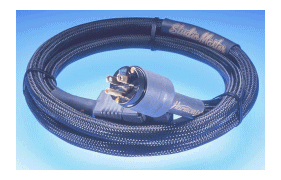 The Harmonic Strings
X-DC Studio Master power cable is black, of average diameter and
flexibility, with over-sized, very high-quality terminations. The
standard product comes with a Furutech F1-15 and WATTaGATE 330, but you
can get it with all WATTaGATE connectors for a slight surcharge.
The Harmonic Strings
X-DC Studio Master power cable is black, of average diameter and
flexibility, with over-sized, very high-quality terminations. The
standard product comes with a Furutech F1-15 and WATTaGATE 330, but you
can get it with all WATTaGATE connectors for a slight surcharge.
Construction quality of the HS-101GP, HS-101SLC and the X-DC Studio Master power cable meet expectations for this price level. All cables use high-purity Oxygen-Free Copper conductors. RCAs are custom designed using copper, gold and rhodium plating.
The Harmonic Strings X-DC Studio Master power cable is my favorite of the group. While all HS cables have great bass, the X-DC Studio Master even has more of it. The Harmonic Strings HS-102 digital cable, on the other hand, has less warmth and bass. It's the most neutral, but it's still the weightiest digital cable I have on hand.
Caveat Emptor
If you ever need an example of how important cable burn-in is, this is it. On my first go ‘round with the HS, after they had about 250 hours, they were obviously romantic with a disproportionate low-end. Even after making adjustments the bottom was too full and the top verged on thinness. Reverberation trails lasted too long and lingered about in that abundant bottom. The HS-102 digital cable suffered from different maladies: it had a bit of a golden glow on top and some ringing in the decay.
At this point, the wires were needed elsewhere and shipped out. When they returned a few months later, the manufacturer's rep guaranteed me that they were sufficiently burned-in, at least four to five hundred hours. Sure enough, the romance was largely purged and they sounded more neutral. Just to be on the safe side, I asked a friend to burn them on his AudioDharma Cable Cooker. Afterwards, when we listened, we were shocked. They were still warm, but much closer to neutral, and the frequency range had evened out: They were almost un-romantic. The "cooked" cables were used in this review.
Conclusion
Unlike some other wire brands, which strive for accuracy and detail and the music be damned, the explicit goal of the Harmonix HS cables is to create a beautiful and pleasing sound. Advertised as the "World's First Tuned Cables," they make music that sounds like it's taking place in the world's best concert hall, and you're in the best seat imaginable.
The major improvements are the banishment of brightness, the augmentation of body and fullness, and the clarification of the musical line. The HS treble is pure and integrated into the fabric of the sound—in other words, supported. Low-end output is abundant: you'll need to adjust for it. But once adjusted, you'll have a balanced frequency response with good extension on top, a beefy mid-range and great low-end. There's all the harmonic richness you could want. And the PRAT factor was almost off the curve. The means to these ends are noise reduction and tuning.
There are a few areas to be aware of. Images have soft boundaries making the overall sound smooth and on the warm side. You may find it too smooth, especially in the upper frequencies. Most guys liked this. Others wanted more bite or edge. The quality of "air" in the soundstage is unlike what we're used to. The very attractive solidity and the weight of the images makes for a convincing facsimile, but also gets in the way of the images' ability to "dance" around the soundstage.
Still, on balance the HS wires do things that bring me closer to the sound I have in my head. Judging from their comments, the evidence suggests this is the sound in the heads of my visitors, too.
Note: This review was done while my reference system was being tweaked out with a lot of Harmonix Tuning products, including footers, Tuning dots and Enacom AC filtering devices. My wife even let me apply Tuning Discs to the walls and ceiling of the room, turning it into a minimalist stucco fashion statement. It looks kind of wild to me, but she doesn't seem to mind.
Harmonix Wire
Retail:
HS-101SLC
Loudspeaker cable $2665 (2 meter)
HS-101GP
Interconnect cable $1530 (1 meter)
HS-102 Digital
cable $990 (1 meter)
X-DC Studio Master
power cord $1170 (2 meter)
Harmonix Combak
Corporation
4-20, Ikego
2-chome, Zushi-shi
Kanagawa 249-0003
Japan
TEL:
(81) 468. 72. 1119
email address:
[email protected]
web address:
www.combak.net
US Distributor
May Audio Marketing, Inc
Niagara Falls NY 14304
TEL: 716. 283. 4434
email address:
[email protected]
web address:
www.mayaudio.com
